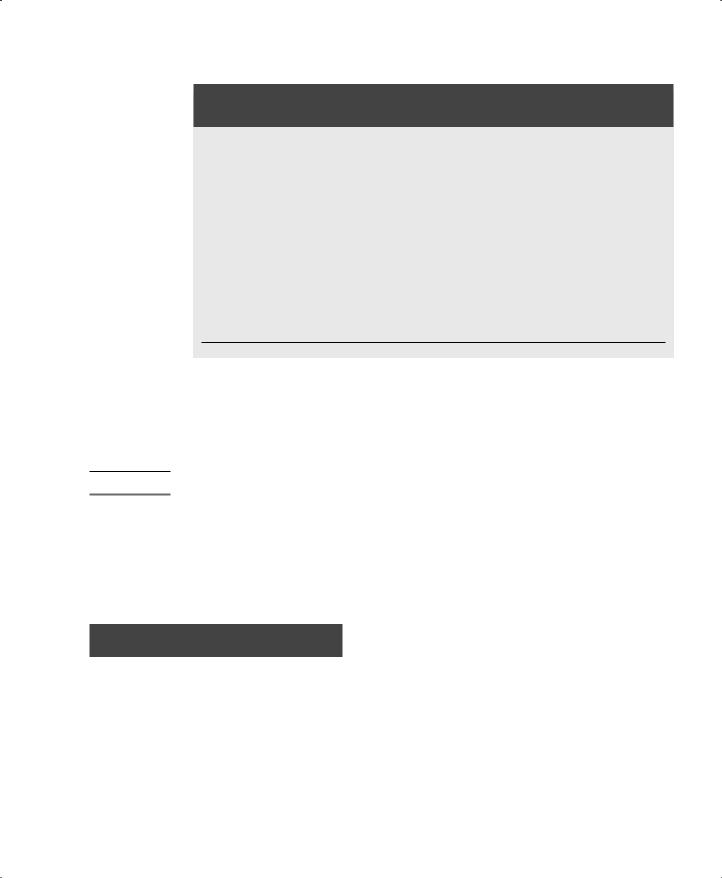
- •Contents
- •Preface
- •Acknowledgments
- •Founders of the Hotel Industry
- •E. M. Statler
- •Conrad Hilton
- •Cesar Ritz
- •William Waldorf Astor and John Jacob Astor IV
- •Kemmons Wilson
- •Ernest Henderson and Robert Moore
- •Ray Schultz
- •Historical Developments
- •Atrium Concept
- •Select-Service Hotels
- •Technological Advances
- •Marketing Emphasis
- •Total Quality Management
- •Major Reorganization, 1987–1988
- •Hotel Investment
- •September 11, 2001
- •Economic Downturn of the Late 2000s
- •Overview of the Hotel Industry
- •Types of Lodging Facilities
- •Hotels
- •Motels
- •All-suites
- •Select-service Hotels
- •Extended-stay Hotels
- •Market Orientation
- •Sales Indicators
- •Occupancy
- •Average Daily Rate (Average Room Rate)
- •Yield Percentage
- •RevPAR (Revenue per Available Room)
- •Levels of Service
- •Business Affiliations
- •Chain Affiliation
- •Referral Property
- •Company-owned Property
- •Management Contract Property
- •Brands
- •Independent Properties
- •Trends That Foster Growth
- •Leisure Time
- •The Me/Pleasure Concept
- •Discretionary Income
- •Family Size/Household Size
- •Business Travel
- •Female Business Travel
- •Travel as Experience
- •Career Development
- •Educational Preparation
- •Work Experience
- •Professional Memberships
- •Ports of Entry
- •Researching Growth Areas in the Hospitality Industry
- •Solution to Opening Dilemma
- •Chapter Recap
- •End-of-Chapter Questions
- •Notes
- •Key Words
- •Organization of Lodging Properties
- •Organization Charts
- •Typical Job Responsibilities of Department Managers
- •General Manager
- •Assistant General Manager
- •Food and Beverage Director
- •Physical Plant Engineer
- •Executive Housekeeper
- •Human Resources Manager
- •Marketing and Sales Director
- •Front Office Manager
- •Controller
- •Director of Security
- •Parking Garage Manager
- •Organization of the Front Office Department
- •Typical Front Office Organization
- •Select-service Hotel Front Office Organization
- •Function of the Front Office Manager
- •Job Analysis and Job Description
- •The Art of Supervising
- •Staffing the Front Office
- •Solution to Opening Dilemma
- •Chapter Recap
- •End-of-Chapter Questions
- •Key Words
- •Role of the Front Office in Interdepartmental Communications
- •Front Office Interaction with Other Departments in the Hotel
- •Marketing and Sales Department
- •Housekeeping Department
- •Food and Beverage Department
- •Banquet Department
- •Controller
- •Maintenance or Engineering Department
- •Security Department
- •Human Resources Management Department
- •Analyzing the Lines of Communications
- •Situation 1: Marketing and Sales Knows It All—But Didn’t Tell Us
- •Situation 2: Peace and Harmony in 507
- •Situation 3: I Know What You Said, and I Think I Know What You Mean
- •The Role of Total Quality Management in Effective Communication
- •An Example of Total Quality Management in a Hotel
- •Solution to Opening Dilemma
- •Chapter Recap
- •End-of-Chapter Questions
- •Key Words
- •Physical Structure and Positioning of the Front Desk
- •Guest First Impression
- •Creating a Balance Between Guest Flow and Employee Work
- •Selecting a Property Management System
- •Importance of a Needs Analysis
- •Procedure for Performing a Needs Analysis
- •Selecting a Team
- •Analyzing the Flow of Guests through the Hotel
- •Communicating Information
- •Reviewing Administrative Paperwork
- •Management Review of Information
- •Evaluate Needs That Have Been Identified
- •Assessing Needs Based on Findings
- •Choosing Software
- •Choosing Hardware
- •Other PMS Selection Considerations
- •Vendor Claims
- •Hardware Installation Plans
- •Computer Training Programs
- •Backup Power Sources
- •Maintenance Agreement
- •Financial Considerations
- •PMS Applications
- •Reservations
- •Revenue Management
- •Registration
- •Room Status
- •Posting
- •Call Accounting
- •Checkout
- •Night Audit
- •Inquiries/Reports
- •Back Office
- •Housekeeping
- •Food and Beverage
- •Maintenance
- •Security
- •Marketing and Sales
- •Personnel
- •Electronic Mail
- •Time Clock
- •Solution to Opening Dilemma
- •Chapter Recap
- •End-of-Chapter Questions
- •Notes
- •Key Words
- •Importance of a Reservation System
- •Overview of the Reservation System
- •Choice Hotels International
- •Hilton Hotels
- •Marriott International
- •Global Distribution Systems (GDS) in Securing Reservations
- •Role of the Internet in Securing Reservations
- •Background on Room Rates Offered via the Internet
- •Effect of Internet on Pricing Rooms
- •Consumers Response to Use of the Internet—Third-Party Websites
- •Social Media
- •Financial Effects of Third-Party Reservations
- •Types of Reservation Systems
- •Franchisee
- •Referral Member
- •Sources of Reservations
- •Corporate Clients
- •Social/Military/Educational/Religious/Fraternal (SMERF)
- •Meetings/Incentive/Conference/Event (MICE)
- •Group Travelers
- •Leisure Travelers
- •Current Guests
- •Forecasting Reservations
- •Overbooking (Occupancy Management)
- •Revenue Management
- •Processing Guest Reservations
- •Systemwide Reservation Systems
- •Outsourcing Reservations
- •Types of Reservations
- •Reservation Codes
- •Cancellation Codes
- •Blocking Procedure
- •Process of Completing Reservations through a PMS
- •Database Interfaces
- •True Integration
- •Solution to Opening Dilemma
- •Chapter Recap
- •End-of-Chapter Questions
- •Notes
- •Key Words
- •Occupancy Percentage
- •Average Daily Rate
- •RevPAR
- •History of Yield Management
- •Use of Yield Management
- •Revenue Manager
- •Components of Revenue Management
- •Definition of Yield
- •Optimal Occupancy and Optimal Rate
- •Strategies
- •Forecasting
- •Star Report
- •Block-out Periods
- •Systems and Procedures
- •Channel Management
- •Feedback
- •Management Challenges in Using Revenue Management
- •Considerations for Food and Beverage Sales
- •Applications of Revenue Management
- •Scenario 1
- •Scenario 2
- •Scenario 3
- •Solution to Opening Dilemma
- •Chapter Recap
- •End-of-Chapter Questions
- •Notes
- •Key Words
- •Importance of the First Guest Contact
- •Components of the Registration Process
- •Capturing Guest Data
- •Guest Registration Procedure
- •Guest Hospitality
- •Inquiry about Reservation
- •Completion of Registration Card
- •Review Completeness of Registration Card
- •Extension of Guest Credit
- •Room Selection
- •Room Assignment from Inventory
- •Assigning Room Rates
- •Discuss Sales Opportunities
- •Assigning Room Keys
- •Security of the Key System
- •Maintaining the Key System
- •Registration with a PMS
- •Retrieving Reservation Form
- •Checking Room Inventory Option
- •Checking Room Status Option
- •Verifying Room Rate
- •Issuing Room Key
- •Obtaining Reports from the PMS
- •Self-Check-In
- •Solution to Opening Dilemma
- •Chapter Recap
- •End-of-Chapter Questions
- •Notes
- •Key Words
- •Common Bookkeeping Practices
- •Debits and Credits
- •Forms Used to Process Guest Charges and Payments
- •Folio, Transfers, and Paid-out Slips
- •Account Ledgers
- •Guest Ledger and City Ledger
- •Posting Guest Charges and Payments
- •Point-of-sale
- •Room and Tax
- •Transfers and Adjustments
- •Paid-Out
- •Miscellaneous Charges
- •Phone
- •Display Folio
- •Reports
- •Transferring Guest and City Ledgers to Accounts Receivable
- •Solution to Opening Dilemma
- •Chapter Recap
- •End-of-Chapter Questions
- •Key Words
- •Organizing Late Charges to Ensure Accuracy
- •Guest Checkout Procedure
- •Inquiring about Quality of Products and Services
- •Retrieving the Room Key
- •Retrieving and Reviewing the Folio
- •In-room Guest Checkout
- •Determining Method of Payment and Collection
- •Credit Cards
- •Bill-to-account (Direct Billing)
- •Cash and Personal Checks
- •Traveler’s Checks
- •Debit Cards
- •Assisting the Guest with Method of Payment
- •Money Wire
- •Travelers Aid Society
- •Auto Clubs
- •International Currency Exchange
- •Obtaining Future Reservations
- •Filing Documents
- •Relaying Guest Departures to Other Departments
- •Removing Guest Information from the System
- •Transfer of Guest Accounts to the Back Office
- •Checkout Reports Available with a Property Management System
- •Guest Histories
- •ZIP Code or Postal Code
- •Developing Conventions and Conferences
- •FAM Tours
- •Origination of Reservation
- •Frequency of Guest Visit
- •Types of Room Requested
- •Room Rates versus Occupancy Patterns
- •Tracking Social Media
- •Last Impressions of the Hotel
- •Solution to Opening Dilemma
- •Chapter Recap
- •End-of-Chapter Questions
- •Notes
- •Key Words
- •Importance of the Night Audit
- •The Night Auditor
- •The Night Audit Process
- •Posting Room and Tax Charges
- •Assembling Guest Charges and Payments
- •Reconciling Departmental Financial Activities
- •Reconciling Accounts Receivable
- •Running the Trial Balance
- •Goal of Preparing the Night Audit Report
- •Preparing the Night Audit Report
- •Departmental Totals
- •Bank Deposit
- •Accounts Receivable
- •Cashier’s Report
- •Manager’s Report
- •Formulas for Balancing the Night Audit Report
- •Room and Tax
- •Total Restaurant Sales and Sales Tax
- •Tips for Restaurant, Room Service, Banquet, and Lounge Employees
- •Room Service
- •Banquet Sales
- •Banquet Bar and Total Lounge Sales
- •Room Rental
- •Valet
- •Telephone Charges
- •Gift Shop Sales and Tax
- •Vending
- •Parking
- •Total Revenue and Total Write-Offs
- •Cash Sales and Accounts Receivable Balance
- •Credit Cards and Cash Applied to Accounts Receivable
- •Analysis of Accounts Receivable
- •Bank Deposit and Amount Transferred to Accounts Receivable
- •Cashier’s Report
- •Operating Statistics
- •Daily Flash Report
- •Reading the Flash Report
- •Reading the Night Audit
- •Solution to Opening Dilemma
- •Chapter Recap
- •End-of-Chapter Questions
- •Key Words
- •Importance of Hospitality
- •Managing the Delivery of Hospitality
- •Management’s Role
- •The Service Strategy Statement
- •Financial Commitment
- •Total Quality Management Applications
- •Developing a Service Management Program
- •Guest Cycle
- •Moments of Truth in Hotel Service Management
- •Employee Buy-in Concept
- •Screening Employees Who Deliver Hospitality
- •Empowerment
- •Training for Hospitality Management
- •Evaluating the Service Management Program
- •Follow-through
- •Interfacing with Other Departments in Delivering Hospitality
- •Customer Relationship Management
- •Solution to Opening Dilemma
- •Chapter Recap
- •End-of-Chapter Questions
- •Notes
- •Key Words
- •Determining Employee Hospitality Qualities
- •Job Analysis and Job Descriptions
- •Positive Hospitality Character Traits
- •Practicing Promotional Skills
- •Screening for Hospitality Qualities
- •An Outgoing Personality
- •Patience
- •Ability to Accept Constructive Criticism
- •Interest in Selling
- •Developing an Orientation Program
- •Economic Position of the Property in the Community
- •Overview of the Lodging Establishment
- •Employee Handbook
- •Policy and Procedure Manual
- •Introduction to the Front Office Staff
- •Equipment Overview
- •Interdepartmental Cooperation
- •Administering the Orientation Program
- •Selection of Orientation Leader
- •Developing a Training Program
- •Identification of Tasks and Job Management Skills
- •Preparing Step-by-Step Procedures
- •Management Concepts
- •Steps in the Training Process
- •Preparation: Get Ready
- •Delivery: Show Me
- •Administering a Training Program
- •Cross-training
- •Developing a Trainer
- •Job Knowledge
- •Training for Empowerment
- •Americans with Disabilities Act
- •Solution to Opening Dilemma
- •Chapter Recap
- •End-of-Chapter Questions
- •Notes
- •Key Words
- •The Role of the Front Office in Marketing and Sales
- •Planning a Point-of-sale Front Office
- •Set Objectives
- •Brainstorm Areas for Promotion
- •Evaluate Alternatives
- •Devise Incentive Programs
- •Theories of Motivation
- •Douglas McGregor
- •Abraham Maslow
- •Elton Mayo
- •Frederick Herzberg
- •Applying Motivation Theories
- •Maslow
- •Mayo
- •Herzberg
- •Training Programs for a Point-of-sale Front Office
- •Train in Sales Skills
- •Develop an Attitude of Presenting Opportunities
- •Let Employees Experience Hotel Services
- •Use Role-Playing to Create Your Own Training Video
- •Budgeting for a Point-of-sale Front Office
- •Feedback
- •Guest Test
- •Financial Results
- •Planning a Point-of-sale Front Office—An Example
- •Solution to Opening Dilemma
- •Chapter Recap
- •End-of-Chapter Questions
- •Notes
- •Key Words
- •Importance of a Security Department
- •Organization of a Security Department
- •Job Analysis of the Director of Security
- •In-House Security Departments versus Contracted Security
- •Room Key Security
- •Hard-key System
- •Electronic Locks System
- •Smart Card
- •Contactless Electronic Locks
- •Fire Safety
- •General Fire Code Requirements
- •Guest Expectations
- •Fire Safety Plan
- •Employee Training in Fire Safety
- •Guest Instruction in Fire Safety
- •Fire Action Communication Procedure
- •Emergency Communication
- •Developing the Emergency Communication Plan
- •Employee Safety Programs
- •Employee Safety Committee
- •Composition and Activities of the Safety Committee
- •Department Supervisors’ Responsibility
- •Safety Training Programs
- •Solution to Opening Dilemma
- •Chapter Recap
- •End-of-Chapter Questions
- •Notes
- •Key Words
- •Importance of the Housekeeping Department
- •Overview of a Housekeeping Department
- •Relationship of the Executive Housekeeper to the General Manager
- •Management of a Housekeeping Department
- •Room Assignment/Workload
- •Outsourcing Housekeeping Activities
- •Housekeeper’s Report
- •Communication
- •Situation 1: Why Can’t Room Attendants Get Those Rooms Cleaned More Quickly, or, If That Guest Asks One More Time…
- •Inventory Control
- •Fixtures
- •Theft Control of Inventory
- •In-house Laundry versus Outsourced Laundry
- •Occupational Safety and Health Administration
- •Material Safety Data Sheets
- •Americans with Disability Compliance
- •Professional Associations
- •Role of Chief Engineer in a Lodging Property
- •Job Analysis
- •Job Description
- •Technology
- •Managing Maintenance Inter-departmental Communications
- •Energy Management
- •The Greening of the Lodging Industry
- •Leadership in Energy and Environmental Design (LEED)
- •Solution to Opening Dilemma
- •Chapter Recap
- •End-of-Chapter Questions
- •Notes
- •Key Words
- •Glossary
- •Index

S O L U T I O N T O O P E N I N G D I L E M M A 167
F I G U R E 5 - 1 4 The Guest Message screen is available for front office staff at a
moment’s notice.
MESSAGE—GUESTS
BRINKE, L. W. 01 02 12:57 P.M.
TOM WASKIN OF GN MERCH IS NOT ABLE TO KEEP APPT ON 01 02 AT 4:00 P.M.
CALL HIM TO RESCHEDULE 000-000-0000 BEFORE 7:00 P.M. 01 02. SWE
BRINKE, L. W. 10 12 1:38 P.M.
JENNIFER HOW OF STERN ELEC WILL MEET YOU AT 5:00 P.M. IN TIMES HOTEL LOBBY AS PLANNED. BRING ALONG DATA ON RESEARCH PROJECT 21-Z. SWE
occupancy in mind. Maintenance crews plan refurbishing and repairs when projected occupancy is low. Food and beverage directors can promote a positive cash flow by increasing food and beverage marketing programs during slow room sales periods. The controller also needs to access the reservation database when planning fiscal budgets.
True Integration
The term true integration denotes a hotel’s central reservations system and property management sharing a database. Rebecca Oliva describes how the CRS and PMS use the same database for processing reservations.24 This allows for real-time reservations, a perceived benefit for consumers, as well as a lower technology investment for data storage, a benefit for hotel investors. Hotels can access reservation data via the Internet.
Solution to Opening Dilemma
The override feature of the reservation module in a property management system allows individual employees to book reservations beyond the number of rooms available and beyond the occupancy management limit. This feature must be controlled by the reservations manager, front office manager, or manager on duty. The front office staff must investigate room availability in nearby hotels and notify guests that their room reservations will be handled at another hotel. In some cases, guests can’t be notified prior to their arrival, and the front desk staff must be prepared to deliver customer service with utmost composure.

168 C H A P T E R 5 ■ S Y S T E M W I D E R E S E R VAT I O N S
Chapter Recap
This chapter addressed hotel reservation systems. As the popularity of computerized reservation systems has increased, chains and referral properties have adopted them to meet the needs of the traveling public. The consumer’s increasing reliance on the Internet and social media to make room reservations has affected the profitability of hotels.
Reservations ensure that corporate, group, and leisure travelers have accommodations at their destination and provide the hotel with a steady flow of business. Determining the sources of these reservations assists the front office manager in developing procedures to satisfy the needs of guests. The traveler can use various means to make reservations, such as toll-free telephone numbers, fax numbers, the Internet, and social media. The concept of customer relationship management links hospitality and technology. The management of social media applications helps develop this concept.
The rooms forecast is used to communicate occupancy status to other departments in the hotel. Overbooking, used to balance no-shows and understays, can be carefully structured using the occupancy management formula. Computerized reservation systems also help front office managers manage guest information databases, dates of arrival, lengths of stay, and so forth. Confirmed and guaranteed reservations assure the guest of accommodations on arrival, with various degrees of assurance based on time of arrival and willingness to prepay. These levels of assurance also affect the financial success of the hotel. All elements discussed in this chapter combine to provide means of access for the guest and a technique for marketing rooms for the hotel. The front office manager is responsible for providing this service to the guest.
End-of-Chapter Questions
1.How does a well-organized reservation system meet the needs of travelers?
2.How does the lodging industry meet the need of travelers for assured reservations?
3.What advantages does a hotel belonging to a reservation/referral system enjoy?
4.What are the major sources of guest reservations? What information does this analysis reveal?
5.How can a lodging property use social media to communicate reservation offers?
6.Discuss which social media are appropriate for corporate clients, leisure traveler, and SMERF.
7.Discuss the nature of a typical corporate client’s travel plans, and explain how these plans are supported by a well-organized reservation system. What reservation access methods are available to corporate clients?
8.Why are tour or meeting planners important to the hotel with regard to group reservations? What reservation access methods are available to group tour planners?

E N D - O F - C H A P T E R Q U E S T I O N S 169
9.How do leisure travelers differ from corporate clients and group travelers? What reservation access methods are available to them?
10.If you have been or are currently employed at a front desk in a hotel, what do you think of the potential for repeat business from current guests? Does your hotel have a procedure to secure reservations on check-in or checkout?
11.Why is it necessary to prepare a rooms forecast? What are the components of this management tool? Besides the front office manager, who uses the room forecast?
12.What does overbooking mean? Discuss the legal and financial implications of this practice.
13.What are the components of an aggressive occupancy management procedure? How are they applied to the occupancy management formula?
14.What are the major steps involved in processing a guest reservation?
15.Briefly describe the method used to process a reservation with a computerized system.
16.Discuss the differences between confirmed reservations and guaranteed reservations. What financial implications does each entail?
17.Design a reservation code for a computerized reservation system. Why did you choose the control features in your code?
18.Develop a cancellation code for a computerized reservation system. Why did you choose the control features in your code?
19.What does room blocking involve? Give examples.
20.How do you think true integration of the central reservation system and a hotel’s property management system affect guest satisfaction and the hotel’s financial success?
C A S E S T U D Y 5 0 1
Margaret Chu, general manager of The Times Hotel, and Ana Chavarria, front office manager, are in the process of developing a policy on overbooking. The current policy prohibits the reservations manager from booking more than 100 percent of the available rooms. Reservations are composed of 60 percent confirmed and 40 percent guaranteed.
In the past six months, about 5 percent of confirmed reservations have been no-shows, resulting in a financial loss of about 500 room-nights. This situation has not been analyzed because Ms. Chavarria has not had time to organize such a study. The loss
of $42,500 (500 rooms 3 $85 average room rate) has forced management to consider developing an aggressive occupancy management program.
Offer some suggestions to Ms. Chu and Ms. Chavarria concerning the following related concepts: the legality of overbooking, the need to maintain an accurate accounting of the financial impact of noshows, and the management of the reservation/occupancy categories that make up the hotel’s room sales (confirmed reservations, guaranteed reservations, stayovers, understays, and walk-ins).

170 C H A P T E R 5 ■ S Y S T E M W I D E R E S E R VAT I O N S
C A S E S T U D Y 5 0 2
Use the following data to prepare a rooms forecast for the first week of May for The Times Hotel:
Number of rooms available 5 600
Number of rooms occupied on April 30 5 300
May 1:
Departures 5 200 rooms
Arrivals 5 200 rooms (70 percent confirmed, 30 percent guaranteed)
Walk-ins 5 40 rooms
No-shows 5 0.02 percent of expected arrivals
May 2:
Departures 5 50 rooms
Arrivals 5 100 rooms (60 percent confirmed, 40 percent guaranteed)
Walk-ins 5 10 rooms
No-shows 5 0.02 percent of expected arrivals
May 3:
Departures 5 200 rooms
Arrivals 5 100 rooms (50 percent confirmed, 50 percent guaranteed)
Walk-ins 5 20 rooms
No-shows 5 0.02 percent of expected arrivals
May 4:
Departures 5 50 rooms
Arrivals 5 100 rooms (20 percent confirmed, 80 percent guaranteed)
Walk-ins 5 10 rooms
No-shows 5 0.01 percent of expected arrivals
May 5:
Departures 5 300 rooms
Arrivals 5 70 rooms (30 percent confirmed, 70 percent guaranteed)
Walk-ins 5 25 rooms
No-shows 5 0.0143 percent of expected arrivals
May 6:
Departures 5 50 rooms
Arrivals 5 175 rooms (92 percent confirmed, 8 percent guaranteed)
Walk-ins 5 10 rooms
No-shows 5 0.04 percent of expected arrivals
May 7:
Departures 5 200 rooms
Arrivals 5 180 rooms (10 percent confirmed, 90 percent guaranteed)
Walk-ins 5 25 rooms
No-shows 5 0.0223 percent of expected arrivals
C A S E S T U D Y 5 0 3
Margaret Chu, general manager of The Times Hotel, Lorraine DeSantes, director of marketing and sales, and Ben DiCanta, revenue manager, are interested in developing social media options for attracting guests. Margaret is a member of LinkedIn and feels that media would be a good marketing option. Tom
says Facebook is the way to go. Lorraine says Twitter is the in thing and will generate more customers than they can handle.
They are aware that they should start slowly and have a plan. What tips could you provide to start them on the right path?
